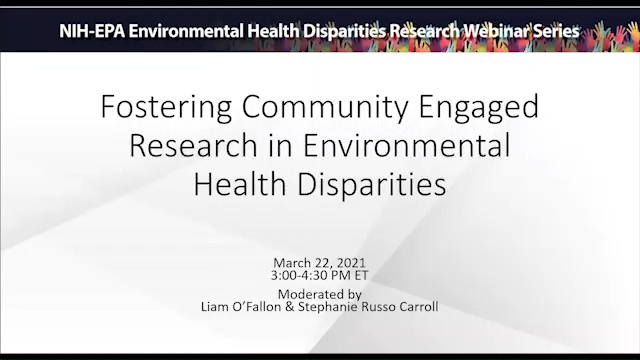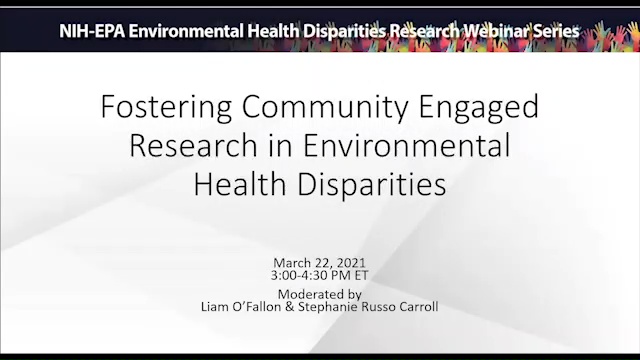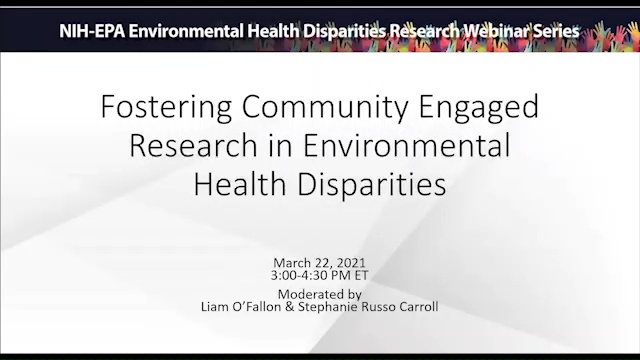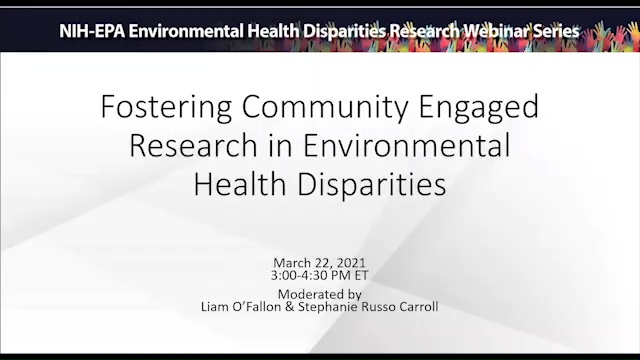Fostering Community Engaged Research in Environmental Health Disparities
Moderators: Stephanie Russo Carroll (Ahtna-Native Village of Kluti-Kaah), Assistant Professor, University of Arizona and Liam O'Fallon Health Specialist, Population Health Branch, NIEHS
| Time | Event |
|---|---|
| 3:00-3:05 p.m. |
Introduction of Presenters |
| 3:05-3:25 p.m. |
Project to Understand the Sources and Health Impacts of Local Air Pollution: Building Community-Academic Partnerships in South Central LA |
| 3:25-3:45 p.m. |
Radon Knowledge and Testing Among Pueblo Communities in Northern New Mexico |
| 3:45-4:05 p.m. |
Combining Evidence-Based Health Literacy Tools & Computer Programming Tools to Create Accessible, Individualized Report-Backs to Meet Communication Goals |
| 4:05-4:30 p.m. |
Discussion and Questions & Answers |
NIH-EPA Environmental Health Disparities Research Webinar Series
Part 1 - Intro and Presentation #1

Part 2 - Presentation #2

Part 3 - Presentation #3

Part 4 - Q&A and Closing

Abstracts
Project to Understand the Sources and Health Impacts of Local Air Pollution: Building Community-Academic Partnerships in South Central LA (4MB)
Investigators: Jill Johnston, Amanda Jimenez, Paula Torrado
Abstract: The multiethnic neighborhoods of South Central Los Angeles are exposed to multiple pollution sources compounding effect of social and economic stressors. These communities have one of the highest asthma emergency visits and hospitalization rates in LA and face among the highest levels of air pollution in the state of California yet there are no air monitors in the community. Launched in January 2019, the innovative project, the Project to Understand the Sources and Health Impacts of Local Air Pollution (PUSH), brought together residents of South Central LA, community advocates, and academics (led by the CEC of the MADRES Center) to shape a community air training and monitoring program rooted in a local understanding of the multi-faceted dimensions of air pollution burden. We developed a popular education approach grounded in the experiences and expertise of South Central LA residents. The PUSH coalition implemented a collaborative and creative process for building our community’s capacity to understand and assess the state of air quality and its impacts on community health and well-being. We describe three core strategies: train residents and advocates through the Air Quality Academy, collect data through ground truthing, and through direct engagement with the regulators and policymakers. Our project modeled a language justice framework, that is, the creation of equitable multilingual spaces to effectively foster dialogue around community concerns, scientific findings, and policy strategies. During the first year 70 residents were trained in 4 two-day Air Quality Academies in the science of air pollution, the process of collecting data, and how to engage in policy and regulatory change. We coupled ground-truthing with analyzing regulatory data to map gas stations, auto body shops, metal manufacturing facilities, dry cleaners and oil wells of concern. Five community monitors were deployed, that show elevated PM2.5 levels nearly 60% of the days in 2019-2020. The process community science coupled with local leadership has resulted in renewed attention and funding from the regulators to address air pollution hazards in South Central. Looking forward, this collaborative with model programs to address these sources of pollution from a just transition, workforce development and emissions reductions.
Radon Knowledge and Testing Among Pueblo Communities in Northern New Mexico (1MB)
Investigators: Co-PIs Sheldwin Yazzie and Joseph Hoover, University of Mexico
Abstract: Radon exposure is a concern among tribal communities in northern New Mexico. In 2017, the Albuquerque Area Southwest Tribal Epidemiological Center (AASTEC) conducted a Tribal public health needs assessment for the 27 tribes in the AASTEC service area. Initial results from eighteen Tribes indicated concerns about radon exposure and therefore a need to evaluate radon exposure. Building on an ongoing relationship with tribal staff from Nambe Pueblo, the investigators of this pilot project will measure indoor residential radon to characterize representative exposures in the community. The target population is limited to buildings located on Tribal land in Nambe Pueblo.
Note: Results of this pilot project have been released to the Tribes involved. Release beyond these entities is currently under review by the Southwest Tribal IRB. Drs. Yazzie and Hoover will be able to discuss the research but not the results until IRB approval is obtained
Combining Evidence-Based Health Literacy Tools & Computer Programming Tools to Create Accessible, Individualized Report-Backs to Meet Communication Goals (1MB)
Investigators: Kathryn S. Tomsho, Erin Polka, Chad Milando, Marty Alvarez, Madeleine K. Scammell, Gary Adamkiewicz
Abstract: As increased effort and attention is placed towards data report-back and environmental health literacy, it will be incumbent upon researchers to ensure that environmental health information is provided in a way that is accessible to all audiences, is actionable, and does not perpetuate existing information disparities. Environmental exposure report back data has the potential to increase participant agency by providing detailed information about potential hazardous exposures in a way that may not typically be accessible to the broader public. Effective environmental health data communication requires both an understanding of the audience’s sensemaking of the environmental hazard, as well as the ability of the research team to quickly and rigorously create tailored data communication materials that are suitable for the recipients. In turn, research teams face two major hurdles in providing results back to participants: matching data communication materials to meet participants’ existing environmental health literacy levels, and the time-intensive nature of creating individually tailored reports for all participants. We present a holistic approach to characterizing participants’ environmental health literacy via formative research, a novel automated report-back generation tool and health literacy tools to create tailored report-backs for participants of an indoor air monitoring study.
We will present a two-pronged approach to the report-back creation process in which formative qualitative research and health literacy tools were used to construct a template report-back for participants. We relied on technological and statistical tools to automate the creation of content for individual participant reports by creating an open-source, generalizable report-back tool, called the Macro for Compilation of Report-backs (MCR). The MCR uses Microsoft Visual Basic for Applications (VBA) scripts to compile participant-specific results into individualized reports, and can be used to help researchers and other public health practitioners generate personalized report-backs for participants with the potential to increase the degree of individualization and tailored content.
Additionally, we relied on existing health literacy tools to tailor the reports to meet the participants’ literacy, numeracy, and graphicacy skills in concordance with our communication goals. This approach is generalizable for future report-back efforts and can expedite creation of individual-level reports that facilitate enhanced communication of sophisticated environmental health data to a wide variety of audiences.


